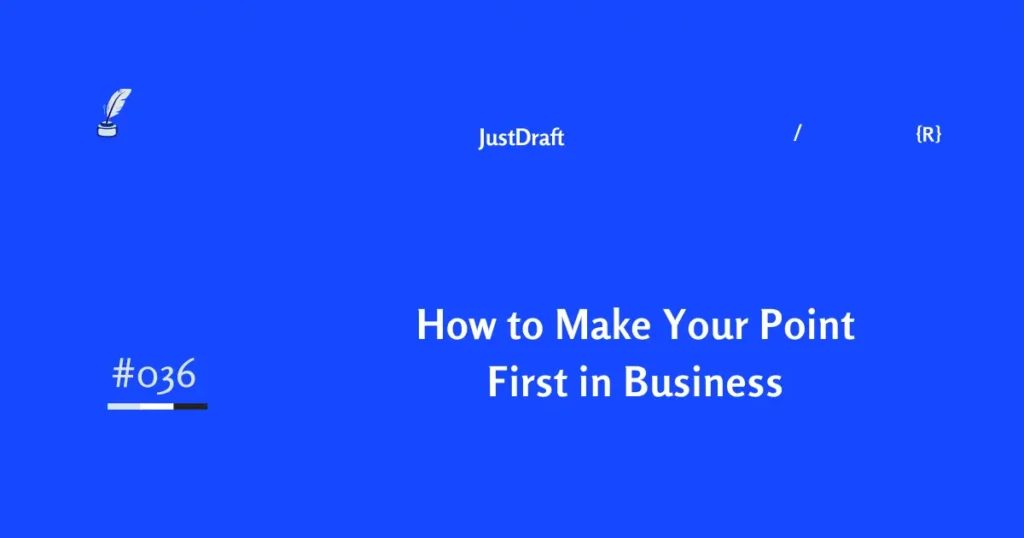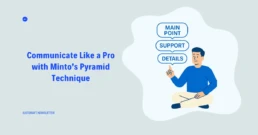Communicate Clearly with the Minto Pyramid Principle
Ever been in a meeting where someone talks for 20 minutes before telling you what they actually want? Frustrating, right?
That’s exactly what Barbara Minto noticed while working at McKinsey in the 1960s. She saw brilliant people burying their main points under mountains of information. So she created something that changed business communication forever. It’s called Minto Pyramid Principle—a powerful communication method.
One Topic: Pyramid Principle
What It Really Is
The Pyramid Principle flips traditional communication on its head:
- Start with your answer or recommendation
- Group and summarize supporting arguments
- Add details only when needed
It’s that simple. Instead of building up to your conclusion, you start with it. This approach works because busy decision-makers don’t have time to follow your entire thought process.
Why Pyramid Principle Works So Well
When you use the Pyramid Principle:
- Meetings get shorter. Everyone understands what we’re discussing right away.
- Decisions happen faster. With the main point clear, we can focus on refining the solution.
- Your ideas get remembered. People recall the first thing they hear.
- Your thinking gets sharper. If you can’t state your main point clearly, you probably don’t understand it well enough.
When it really shines
You don’t need a stage or a TED Talk. Here’s where it fits perfectly:
- Pitching an idea to execs
- Presenting a project update
- Writing a proposal
- Leading a strategy review
- Summarising research
If you’ve got 5 minutes to get buy-in, this is your framework.

When It’s Not The Right Tool
Like any framework, the Pyramid Principle isn’t perfect for every situation:
- When building trust matters more than efficiency. Sometimes relationships require more context and storytelling.
- When delivering bad news. A bit of context before delivering tough messages can help people process them.
- When your audience values process over outcomes. Some cultures and organisations place high value on seeing your full thinking.
Minto Pyramid Principle Example
Case1
Let’s say you need to propose an idea to the leadership team. Instead of building up with market data, competitor analysis, and then revealing recommendation, you can flip it like this,
“We need to launch our product in the Southeast Asian market by Q3. Here’s why:
First, our current markets are saturated with only 3% growth potential. Second, Southeast Asia shows 22% annual growth in our category. Third, we already have distribution partners ready to move.
The key risks are local regulatory approval and pricing strategy, which I’ll address if you want more details.”
Case2
Another Example, let’s say one of your companies faced a tough quarter. Sales had dipped 12%, and the board wanted answers.
Here’s what you can say using Minto’s style:
We need to shift our focus to performance marketing immediately.
Customer behavior is moving online, and we’re lagging.
Competitors increased ad ROI by 30% this quarter. Ours fell by 10%.
That’s it. No fluff.
How To Start Using It Today
Want to try it yourself? Here’s how:
- Before your next email or presentation, write down your main recommendation in one sentence.
- List 2-4 key reasons that support this recommendation.
- For each reason, have detailed evidence ready but don’t lead with it.
- Start your communication with your recommendation, not your thought process.
The hardest part is having the confidence to lead with your conclusion. It feels vulnerable – like you’re putting your neck out. But that’s exactly why it works. It shows conviction and clarity.
The Pyramid Principle – it’s not just about communication style. It’s about respect for people’s time and attention. When someone knows exactly what you’re asking for upfront, they can engage more meaningfully with your ideas.
Try it this week. Start with your answer, then explain why. You’ll be amazed at how much more people hear you.
Read last week’s JustDraft newsletter about ABT Storytelling framework.
Two Quotes to Inspire
The clearest thinkers aren’t those who know the most; they’re those who can distill complexity into simplicity on demand.
Leadership isn’t about having all the answers—it’s about having the courage to state them before anyone asks the question.
One Passage From My Bookshelf
People always ask me, ‘What’s the secret to being a successful CEO?’ Sadly, there is no secret, but if there is one skill that stands out, it’s the ability to focus and make the best move when there are no good moves. It’s the moments where you feel most like hiding or dying that you can make the biggest difference as a CEO. In the end, the most difficult thing about running a company is managing your own psychology. If you can manage your psychology, then you can keep your focus on the mission rather than the low’s and high’s that you’ll inevitably experience.
📚 From “The Hard Thing About Hard Things” by Ben Horowitz
P.S. If you found this helpful, forward it to a colleague who could use some communication clarity. And hit reply to let me know how the Pyramid Principle works for you!


